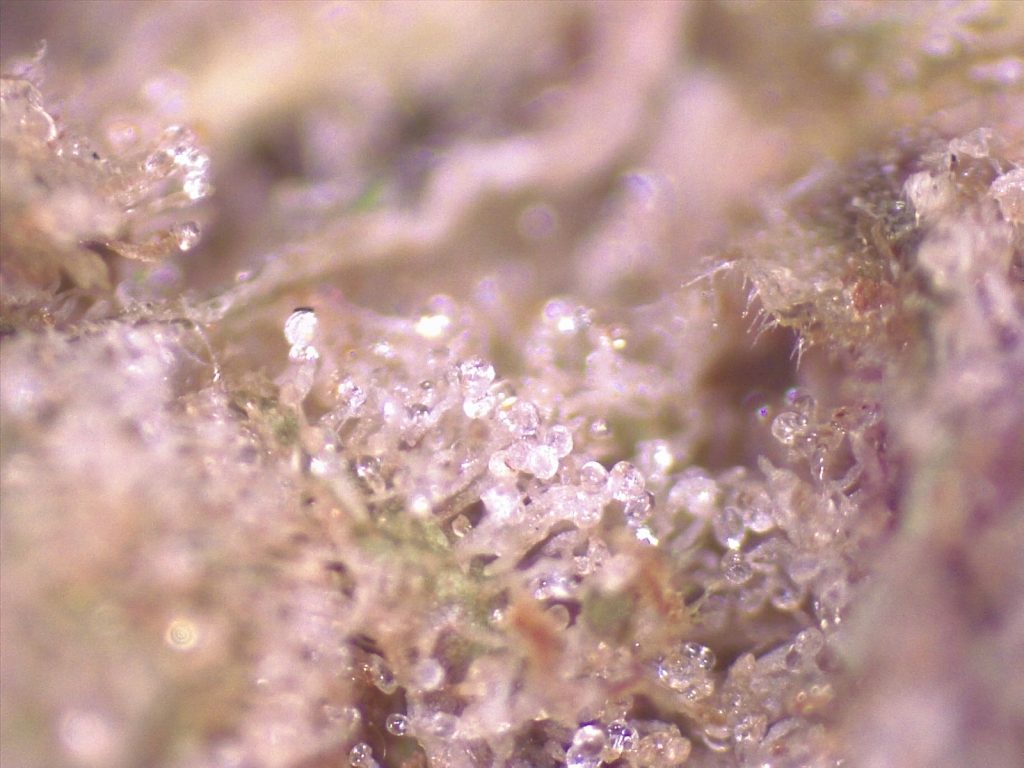October 24, 2019
The oils extracted from hemp and cannabis are rich in CBD and THC respectively. Relative to cannabis, hemp has a low THC concentration but a high CBD concentration. CBD is accepted as a treatment of epileptic seizures, and it is currently all the rage for lotions, doggie treats, and infused beverages. The other, THC, is the one which gives a high when ingested or inhaled. It is gaining acceptance as a medically prescribed pain reliever.
These oils are found in trichomes which are attached to the buds and leaves of the plants. These look like tiny crystalline apples, complete with a stem, as seen in the photo below.
When hemp is grown, harvested, and dried, care is taken to minimize the loss of these trichomes. Belt conveyors are often used for material handling for this reason.
CRUDE PRODUCTION
The first step in producing CBD or THC is to dissolve the trichomes in ethanol. Other solvents, such as heptane and hexane (more flammable) and vegetable oils (less flammable), are being used. Ethanol is the most frequently found. Alternate chemical extraction processes, including supercritical carbon dioxide and butane, are used less frequently for hemp but are common for cannabis extraction. For the extraction step, the goal is to try and reach a saturation of the oils in the solvent.
Once the trichomes are dissolved into the solvent, this extract liquor is separated from the hemp fiber. Vincent screw presses are commonly used in this process. Pressing helps permeate the solvent into the plant, then drives it back out thus increasing oil recovery. The hemp fiber is discarded as it has little or no commercial value.
Filtration of the extract liquor is a required step. Dried hemp and cannabis, when mixed or pressed, crumbles and generates a noticeable amount of fines. These fines are filtered out using mesh filtration. Besides short fibers, there are waxes and lipids to be separated. This is commonly done by “winterizing” the extraction liquor. Winterizing involves chilling the fluid to -20⁰C and even as low as -80⁰C to solidify the waxes and lipids. A wide range of filtration equipment is being used by processors. We see diatomaceous earth filters and filter presses. Chlorophyll is generally removed using activated carbon filtration.
The solvent is recovered for re-use in the production process. What is left over is called crude and contains a cocktail of cannabinoids. Typically, a vertical tube falling film evaporator is used to recover the solvent. Heat is applied which causes the solvent to vaporize. This vapor flows to a condenser where it is returned to liquid form. The concentrate from the evaporator is the crude. It looks like a viscous tar and holds CBD and other cannabinoids.
DISTILLATE PRODUCTION
The crude produced is then fractionated using a distillation column. This column has a heated bottom pot that vaporizes the oils. A portion of this vapor is condensed and returned to the column to exchange with the newly generated vapors. This is called reflux. The non-returned liquid is sent to storage; this is the distillate.
In the crude there are heavy and light oil fractions. CBD, THC and most other cannabinoids are lighter components in the mixture. During distillation, these lighter fractions form a distillate by separating from heavier oils. Hemp oil distillate produced in this process looks very much like ordinary motor oil, clear with an amber or yellow tint. There is a ready market for this product. The bottoms product from the distillation is a thick pitch that contains the long chain oils, remaining waxes, and particulates. The bottoms product is typically discarded as waste. A scraped surface or wiped thin-film evaporator can be used to produce hemp distillate in the same way.
ISOLATE PRODUCTION
Isolate is a pure cannabinoid, such as CBD, and is often crystalline in form. To the naked eye it looks like grains of salt. It is produced from distillate in carefully controlled chemical conditions.
The production of end user CBD products requires careful attention to THC levels. The most common legal specification is that THC cannot exceed 0.3%, by weight. Some processors only process hemp with low THC to avoid THC remediation downstream. From what we have seen, THC remediation is the slowest and most difficult step in producing CBD products. THC and CBD are molecular isomers with boiling points very close to each other. These properties make CBD/THC separation not feasible by traditional distillation. As a result, alternative separation strategies are being used.
The use of column chromatography is key in THC isolation and removal. Another remediation strategy utilizes enzymes immobilized in polymer beads. The enzymes have a specific ‘lock and key’ bonding specific to the THC molecule. As the fluid passes through these beads the THC is absorbed. The remaining distillate is ready for end user formulations and is referred to as a broad-spectrum product. Non-THC remediated distillate is referred to as a full-spectrum product.
Issue #317

